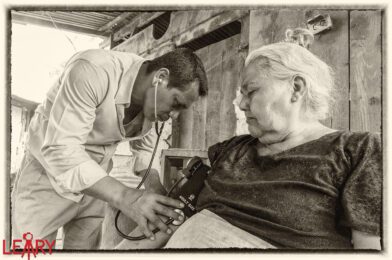| Nikon D5, Sigma 24-105mm f/4 DG OS HSM Art Lens, ISO 32000, ƒ/14, 1/100 |
All the trips I have done overseas have been for humanitarian work. Humanitarian work is concerned with or seeking to promote human welfare.
During this past trip to Nicaragua, there were a lot of opportunities to take care of primary healthcare needs. Now the tricky thing sometimes to do as a humanitarian photographer is to capture and compel the audience to act.
In the homes, they didn’t have a medicine cabinet with your essential bottles of Tylenol, Ibuprofen, Aspirin, cough medicine, and bandaids. If they needed an aspirin, they would go to the city and buy not a bottle but just a few pills. That is all they could afford. I needed to capture the medically trained indigenous volunteers checking blood pressure or giving an IV because handing a person a small ziplock bag of ibuprofen doesn’t read quickly to the audience medical care.
 |
| Nikon D5, Sigma 24-105mm f/4 DG OS HSM Art Lens, ISO 1250, ƒ/4, 1/100 |
The gravity of this moment with medical missionary nurse practitioner Traci Warner isn’t as apparent to the audience visually as I would have wished. Dominga is the lady in the middle with the IV above her head. Her sister is to the left and had just paused a moment from waving the fan to keep her sister comfortable.
Dominga is dying from cancer. After we visited, Dominga would die later that night.
 |
| Nikon D5, Sigma 24-105mm f/4 DG OS HSM Art Lens, ISO 1600, ƒ/4.5, 1/100 |
Missionary nurse practitioner Warner has much more to offer than her medical skills. During this part of life that we all will go through, Warner took the time to read Psalms 23.
Verse 4 speaks to me:
4 Yea, though I walk through the valley of the shadow of death, I will fear no evil: for thou art with me; thy rod and thy staff they comfort me.
This photo captures some of the reasons why I like working with missionaries. They care for the whole person and not just their physical needs, but they are also spiritual.
 |
| Nikon D5, Sigma 35mm ƒ/1.4 DG Art, ISO 200, ƒ/1.4, 1/100 |
If you are taking photos of humanitarian work, you need to keep shooting. Sometimes when you are taking pictures and thinking something better will come along is a mistake. Instead, you shoot everything you can and then pick the moments that best capture the work and the story’s soul.
Here Warner is checking a skin condition on a lady with the Nicaraguan medical volunteer learning about the fungus condition.
Words are paramount to understanding each of these photos. So take notes and describe what is happening in an image and why they are doing something.
 |
| Nikon D5, Sigma 24-105mm f/4 DG OS HSM Art Lens, ISO 100, ƒ/4, 1/160 |
I like this photo of the young girl here. Now without text, it is still a very compelling photograph. However, in the context of the images above, the picture can take on even more meaning but requires the words to help the audience feel even more impact than the visual can do alone.
The young lady leaning on the post is the granddaughter of the lady in the first photo. The lady having her blood pressure taken has high blood pressure that they monitor. However, the medical team did not just give her some medicine to help lower their blood pressure; they helped her by educating her on her diet. So today, she no longer needs the blood pressure medicine but needs to monitor it.
By saving the grandmother, we saved the caretaker of the granddaughter. Now she has someone to watch and take care of her as her parents are both out working to make ends meet for the family.
Many young girls like her are raped and abused due to a lack of adult supervision. Who would think that humanitarian aid through medical training and blood pressure pills would help save this young girl’s life?
Telling people’s stories is why I love traveling the world and helping make people’s lives better. How do I make things better when I am not a nurse practitioner? I help tell these stories and get people like you to give and go to make a difference.
Here are two opportunities this year for you to do the same thing and learn how to do it.
First, we have two openings left for our Storytellers Abroad workshop in Togo, West Africa.
The next opportunity is to travel with Gary S. Chapman and me to Honduras, Central America.
 |
| Nikon D5, Sigma 24-105mm f/4 DG OS HSM Art Lens, ISO 450, ƒ/8, 1/100 |
The workshop is not a classroom class only. Instead, the workshop allows you to produce a complete project that will do what you would if you captured the story on your own. The difference is you have teachers/coaches to help you navigate all the hurdles of storytelling.
If you want coverage like I am overseas, here is your chance. The students we have finished the Storytellers Abroad Workshop have now shown the missions agency ABWE their skills and let the organization get to know them. As a result, many are asking to tell more stories of missionaries worldwide.
Sign up today, and I will see you in either Togo or Honduras very soon.

